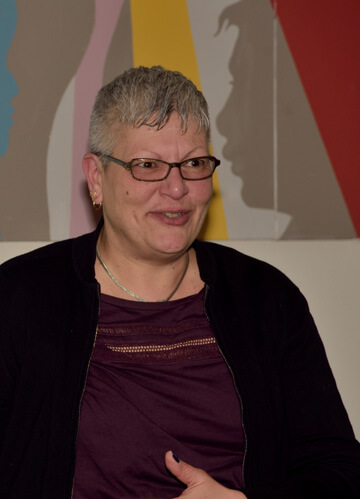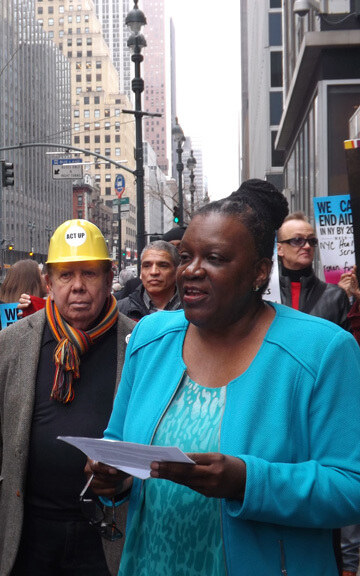BY DAVID NOH | If for no other reason than the poignantly empathic song “At 17,” prolific singer-songwriter Janis Ian is assured a place in music immortality. The troubled youthful reminiscence, released in 1975, has touched a chord with generations of listeners and became a cultural reference point in TV and movies from “The Simpson” to “Mean Girls.”
Years before “17” — in fact when she just 16 — Ian had already sparked big controversy with “Society’s Child,” about an interracial romance. That song went on to become a Grammy Hall of Fame honoree, in 2001.
This week, on February 5, Ian performs in Lincoln Center’s American Songbook series (8:30 p.m., Appel Room, 10 Columbus Circle, Broadway at 60th St., fifth fl.; americansongbook.org).
Janis Ian talks Cosby homophobia, gay history, and, of course, “At 17”
The New York City native last performed solo here four years ago, and she said her show will be “a combination of old and new stuff. Up until a few days ago, it was my only show of the year, but I just got two more interesting offers. One to play with Buffy St. Marie and one that’s an LGBT thing with the San Diego Women’s Chorus. I’ve been sort of touring since 1993, and I thought, ‘I don’t want to do that anymore.’
“I’m in my 60s, and it’s a different thing. I looked at my 50s as my ‘fuck you’ years, I didn’t expect to still be here, so what are you gonna do to me? In my 60s, I don’t have as much tolerance as I used to — and I didn’t have a lot to begin with. But in a weird way, I have a lot more patience. Instead of building, building, and amassing, and trying to be safe with your family, you look around and the clock’s running. I have a pretty well-known author friend who told me, ‘My partner’s 15 years older than me and I’ve written more books than I ever dreamed would be published. So I’m going to spend my remaining time with her. First, I’ll still have plenty of time to write and, second, if I go first I won’t care.’
“I thought about that because my wife [Patricia Snyder] had both knees replaced last year and she got very ill and so did I. After all that, why am I on the road 200 nights a year? It’s crazy. I also know a lot of my contemporaries are gone — Phoebe Snow, Laura Nyro. I’ve been really lucky so far, and I want to enjoy that. There’s also the freedom of being in a long-term relationship. I’ve been with Pat for 27 years, and I’m going to visit friends for Passover, and she’s going to meet up with a mutual friend somewhere else. There’s the freedom of ‘Yeah, you wanna do this and I wanna do this,’ so we coordinate and are away at the same time. I’m at the point where I want to see my friends scattered all over the country and those relationships are valuable to me.”
I wanted to know if coming out was a big deal for her: “Not really, because it was in so many stages. I was outed by the Village Voice in 1977 but the press didn’t pick up on it. It was very kind of them because I would have lost my cabaret card. But still, everyone pretty much knew. And then I fell in love with a man, which confused the issue. Then I was living with a woman, and in the late 1980s and early 1990s, I was going to let the music speak for itself and not make a big deal about it.
“But Urvashi Vaid, who was with what became [the LGBTQ Task Force], told me about all the gay teenage suicides and asked me, ‘Did you ever have a role model who was gay?’ I said, ‘Yeah, “The Well of Loneliness,” which almost convinced me I wasn’t gay.’ And she said, ‘Don’t you wish you had had one? Will you please wait until your record comes out and make a splash?’
“That’s what I did, so technically I guess I came out in 1993 with my record, ‘Breaking Silence.’ Then it got confused because Greg Louganis’ book came out almost simultaneously and it was called ‘Breaking the Silence.’ Back then, it was a big deal and we were worried about our audiences for a while, but I always wanted my shows to be welcoming to everyone, so that worked out really well.”
AIDS was raging at that time.
“I think the epidemic made it so you couldn’t stay hidden anymore. A lot of people who were in hiding and families in denial couldn’t be that way anymore. People like Larry Kramer and ACT UP, whether you agreed with their tactics or not, really forced the issue. It became a matter of life and death — families were throwing gays out of the house then. It was also the first time in my experience that gay women and gay men came together, because up until then it had been two separate worlds. Suddenly gay women were the only ones willing to take care of these men, so that changed things a lot, too.”
Someone else tried to out Ian before she was ready: Bill Cosby. After his rape accusations, she posted about this on Facebook. In 1967, at 16, she met him on the TV set of “The Smothers Brothers Show,” where, drained from nightmares and death threats brought on by “Society’s Child,” Ian fell asleep on the lap of her female chaperone. Her manager called her to say that Cosby had seen this and was trying to get her blacklisted on TV, saying she was a lesbian and not suitable family entertainment.
“He’s a total jerk and his wife is a complicit jerk, and they should both be ashamed of themselves, and I hope all those suits against him win. What he did to me was absolutely unconscionable, but what he did raping those women is on another whole other level. And then denying, denying, denying, and then suing them, what fucking hubris!
“His attitude is ‘I can destroy you and nobody can touch me.’ And it was true for a long time. I had a really moving thing after I wrote that Facebook post. The husband of my tour manager back then called me and said, ‘Thank you because she’s never talked to anybody about it but me.’ I talked to her and she said, ‘I just didn’t think anybody would believe us. So I thought it was put up or shut up.’ Cosby had also said some really cruel things about her, and I thought, ‘Shit, if I had known that then, it would have been damn the torpedoes! Very cruel, and so unnecessary. Outside of the fact that I was 16 and she was straight, what business of his was it? Well, he will get his. I mean karma comes around, sooner or later.
“That’s why the silence is so deadly. There’s a point where keeping silent about something that happens to you is dangerous because we know now that, physiologically, the narrative really takes the trauma out of the area of the brain and moves it to another area. So, even if it’s telling a complete stranger, like a bartender, that is healing.”
Like millions of others, when I first heard “At 17” — as a kid in Hawaii — it made an indelible impression on me, which I shared with Ian.
“Thank you. And what blows me away now is that the song is now in its fifth generation, still with that kind of reach. It’s unbelievable to have written something that has entered the culture of so many countries and crossed the socioeconomic strata.
“I’m grateful every time I sing it, and never really get tired of it. Part of a writer’s goal, I guess, is to do good in the world, and that song has done more good than I will ever personally do. I sing it on stage and I see people mouthing the words — men and women of all ages — astonishing.”
Ian performed it on the debut show of “Saturday Night Live,” and it won the 1975 Grammy — over Linda Ronstadt, Helen Reddy, and Olivia Newton-John.
She said, “I only vaguely remember sitting there the night of the awards and being so surprised. It’s always a shock, you never expect to win, and another reason to be grateful. I am actually up for my 10th nomination now. I just keep saying to all my friends who are nominated, “We’re all golden until February 15, so enjoy it.’ It’s a great thing to be able to say, “I got nominated for a Grammy next month.’ Very few people get to attain that.”
Ian wrote a moving new title song for the HBO series she appeared in, “Getting On.” “[My co-stars] Laurie Metcalf and Alex Bornstein were brilliant, and Rita Moreno on top of it, how hard was that? It was tremendous. Any funny stories? Nothing printable [laughs], but I will say that I was there for two weeks and those were some of the best two weeks of my entire life. I have rarely ever had so much fun: everybody on that set loved each other and were all pulling together. It was devastating that it was ending, but we’re actually seeing Laurie in ‘Misery’ and I hear she’s great in it. She’s amazing, anyway. Everybody was so good to me and I was so relieved that they were all so nice.
“I’m glad you liked the song. I really like it, and I was able to use some of what I learned in acting class with Stella Adler. We became good friends and we corresponded a lot. The day after she died, I got her Hanukkah card. She was very good to me, but I agree with you, she was terrifying, absolutely. My entire first year with her I spent making sure I wasn’t noticed.
“But she followed my career, would critique my songs, and send me these long thoughts about them. When I was in New York, I would escort her when she needed an escort somewhere, and when she was here in LA, I saw her nearly every day. She was a big part of my life, and you’re right, nobody would have ever thought to connect the two of us together. In my limited experience, great artists are inevitably nice and humble because they know that they were born with this talent.
“I think that’s the important thing about this songwriting series at Lincoln Center. I think the important thing is to have a variety there — or at Carnegie Hall — whatever faults it has, to bring in different types of art. It’s part of what keeps the chaos at bay. The beautiful thing about art to me is that it’s so subjective, and one of the things as you learn as you get older as an artist is to separate yourself enough to know, ‘Yeah, I really don’t like it, but that doesn’t mean it’s not great. It’s just not what I like.
“I don’t have a problem with rap, until you get into the ‘bitches’ and ‘hos’ and homophobia, but I would have that problem with that in any art form. We are going to see ‘Hamilton’ the night after my concert and we’re excited.”
Leonard Bernstein also played a big part in Ian’s life: “Without him, I don’t think ‘Society’s Child’ would ever have gotten played. He was the one who really brought it forward to the world and said, ‘This needs to be heard.’ He was very good to me and followed my career. My uncle used to see him at Tanglewood and they would talk about me. His kids have always been very sweet to me. I didn’t know him well but my connection with the Stella Adler school in New York brings me in contact with Tom Oppenheim, Stella’s grandson, whose father David, was Bernstein’s great love and producer for many years. It was David who brought ‘Society’s Child’ to Bernstein’s attention.
“I do a yearly series of master classes at Adler’s NYU adjunct, so there’s yet another connection. All I need is to find a free apartment in New York. If I I hit the lottery, I would get a small flat here. That would be great.”
I wanted to know if two of Ian’s contemporaries, Joni Mitchell and Laura Nyro — particular favorites of mine — were big influences on her and did she know them?
“Well, Joni started making records after I had already done them, but of course ‘Court and Spark’ is a seminal record. Laura I knew, not terribly well, but well enough to hang out in the studio when she was recording. She was a few years ahead of me at school [the New York City High School of Music and Art] and she was always really lovely to me. I’ve had very few bad experiences with other performers, which is a real stroke of luck.”
Contact David Noh at Inthenoh@aol.com, follow him on Twitter @in_the_noh, and check out his blog at nohway.wordpress.com.


































